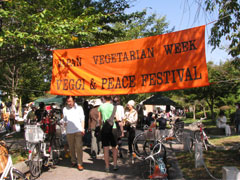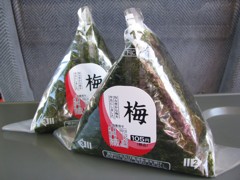… the journal of a South African vegan in Japan
I haven’t blogged about the hellholes called “pet shops” in Japan, or the dearth of fur in the department stores here, and I’m not going to today, but they do form part of this post’s backdrop. The state of animal welfare is dismal in Japan, just like in many other countries – South Africa included. But some things are really, really dismal. Like the stray cat population, for instance.
 Pick a park, any park, poke around in the bushes a little, and you’re bound to find a full-on feral cat colony. Sometimes you won’t even need to look – the cats will caterwaul and come find you, in the hopes of scraps of food. The number of cats that have been abandoned over the years, and bred out in parks, gutters and other areas around cities, is heartbreaking. There are a couple of excellent NPOs working for these kitties; but they’ve really got their work cut out for them.
Pick a park, any park, poke around in the bushes a little, and you’re bound to find a full-on feral cat colony. Sometimes you won’t even need to look – the cats will caterwaul and come find you, in the hopes of scraps of food. The number of cats that have been abandoned over the years, and bred out in parks, gutters and other areas around cities, is heartbreaking. There are a couple of excellent NPOs working for these kitties; but they’ve really got their work cut out for them.
A couple of weeks ago, I went exploring in nearby Shiga Prefecture. I picked one of the lesser-known stations on the train line that goes around Lake Biwako (known for its beaches, floating temple and rowing song), and after disembarking, bushwhacked my way down to the shore. En route I came across a pack of skinny cats, parked under some cars. Their leader padded over and meowed pitifully. He let me pat him – the first cat that I’ve been able to pat in Osaka – and sent me to the nearby convenience store, for food. Nothing kitty-friendly was vegan too, but I bought a few things and went back to feed the cats – they nearly ripped the plastic carry bag to shreds in their desperation! I’d never seen anything like it. It was really awful. I considered stuffing a few into my slingbag, but decided against it – instead I contacted one of the cat NPOs and I’ll be going back on a trap-neuter-release mission soon. Hopefully, I’ll also be able to organise a regular feeder for the cats.
That was just one instance of the feral and stray cat colonies in Japan. There are hundreds more – and yet the hellhole kitten mills just keep turning out more and more pets. I won’t write about the recent occasion when we misguidedly attempted to catnap a stray at a local station … or how it led to my sidekick receiving antibiotics and tetanus shots … but there are times when it’s tough being an animal lover, wherever you are in the world.
This post ends on that note, but with a somewhat lighter postscript:
Pumpkin-flavoured soya milk: This flavour, sometimes called ‘gourd’ here, is difficult to identify at the supaa. It’s difficult to identify what the taste is when you’re drinking it, too – but once you translate the box, it makes absolute sense! It’s a rather tasty flavour; much nicer than the dairy milk, grain and peach flavours I’ve tried – but not as nice as the melon, grape or adzuki bean. Only in Japan. ![]()
 Finding organic soil proved near-impossible. We asked around, in English and Japanese, to no avail. It was either sift through the bags of soil at the nurseries to find a brand with the least fertilisers and other added chemicals, or dig up the local park. The latter posed 2 problems: 1, the risk of getting caught and having to deal with authorities in extremely limited Japanese; and 2, the fact that the soil is compact and very clay-like. We had already acquired 4 pots of this clay-like soil from a construction site down the road (another story altogether). So we opted for the nursery soil. Organic soil is just not one of the conveniences in super-convenient Osaka.
Finding organic soil proved near-impossible. We asked around, in English and Japanese, to no avail. It was either sift through the bags of soil at the nurseries to find a brand with the least fertilisers and other added chemicals, or dig up the local park. The latter posed 2 problems: 1, the risk of getting caught and having to deal with authorities in extremely limited Japanese; and 2, the fact that the soil is compact and very clay-like. We had already acquired 4 pots of this clay-like soil from a construction site down the road (another story altogether). So we opted for the nursery soil. Organic soil is just not one of the conveniences in super-convenient Osaka.  Add some flowers, a rescued hibiscus tree and some organic lavender to the mix and our balcony garden is coming along nicely. Oh, not to mention a cotton tree … never mind vegan veggie gardening –it’s time to take this to the next level – my sidekick has threatened to start weaving her own clothes.
Add some flowers, a rescued hibiscus tree and some organic lavender to the mix and our balcony garden is coming along nicely. Oh, not to mention a cotton tree … never mind vegan veggie gardening –it’s time to take this to the next level – my sidekick has threatened to start weaving her own clothes. There were a handful of gaijin (foreigners), and a lot of Japanese folk of all ages at the buffet. There were even some cute vegan kids running around, munching away and giggling under the tablecloths. The dinner was about exchanging stories, but the big veg fest itself was about showing people how easy it is to be vegetarian or vegan, and why it’s so important that we go flesh-free. We all had to say a few lines on why we were vegan – I could only manage English, but I mentioned environmental, animal and, oft-forgotten, human rights reasons.
There were a handful of gaijin (foreigners), and a lot of Japanese folk of all ages at the buffet. There were even some cute vegan kids running around, munching away and giggling under the tablecloths. The dinner was about exchanging stories, but the big veg fest itself was about showing people how easy it is to be vegetarian or vegan, and why it’s so important that we go flesh-free. We all had to say a few lines on why we were vegan – I could only manage English, but I mentioned environmental, animal and, oft-forgotten, human rights reasons. I just missed Golden Week; being, at that point, in South Africa, and running around like mad to get ready for my move East. Silver Week, however, I was lucky enough to be here for. I marked it in my diary as soon as I touched down in Tokyo. Partner and 2 friends in tow, I headed to the north of the neighbouring prefecture of Wakayama (the south part of which is where the annual dolphin slaughter happens, fyi), to a mountainous village known as Koya-San.
I just missed Golden Week; being, at that point, in South Africa, and running around like mad to get ready for my move East. Silver Week, however, I was lucky enough to be here for. I marked it in my diary as soon as I touched down in Tokyo. Partner and 2 friends in tow, I headed to the north of the neighbouring prefecture of Wakayama (the south part of which is where the annual dolphin slaughter happens, fyi), to a mountainous village known as Koya-San. Onigiri, as they’re known in Japanese, are little triangles of super-processed rice, with a strip of seaweed around the outside, and a bit of filling. Most contain fish, but there are almost always pickled plum (ume) and kelp (kombu) options for us vegans. The filling is written in kanji on the front. No problem, I thought, because the packets are colour-coded too. At Lawsons (a huge chain of konbinis; they even appear as landmarks on Google Maps), purple means plum and green means seaweed. Unfortunately, at other stores (there are about 4 other major chains – 7/11, FamilyMart, am/pm and Sunkist), green also means fish, and I had the unpleasant experience of biting into a rice ball and staring into the eyes of about 100 tiny, dead fish. Moral of the story? Learn kanji, and bite with caution!
Onigiri, as they’re known in Japanese, are little triangles of super-processed rice, with a strip of seaweed around the outside, and a bit of filling. Most contain fish, but there are almost always pickled plum (ume) and kelp (kombu) options for us vegans. The filling is written in kanji on the front. No problem, I thought, because the packets are colour-coded too. At Lawsons (a huge chain of konbinis; they even appear as landmarks on Google Maps), purple means plum and green means seaweed. Unfortunately, at other stores (there are about 4 other major chains – 7/11, FamilyMart, am/pm and Sunkist), green also means fish, and I had the unpleasant experience of biting into a rice ball and staring into the eyes of about 100 tiny, dead fish. Moral of the story? Learn kanji, and bite with caution! I also visited a really “rad” vegan restaurant in Hommachi, which is about 40 minutes from my flat, easily accessible on the train lines. It’s called Raku (’Luck’) Café, and it’s what locals call a “hole-in-the-wall” – a tiny place with a counter and seats for at most, 6 people. The owner is vegan and really chilled. I’d read about his restaurant on
I also visited a really “rad” vegan restaurant in Hommachi, which is about 40 minutes from my flat, easily accessible on the train lines. It’s called Raku (’Luck’) Café, and it’s what locals call a “hole-in-the-wall” – a tiny place with a counter and seats for at most, 6 people. The owner is vegan and really chilled. I’d read about his restaurant on  I think being vegan in Japan is only tough while you’re figuring out the language, what to buy, and where to eat out. I’m sure it would be the same for a Japanese vegan in South Africa. If you are planning to travel to a place where English isn’t an official language, be sure to learn to ask what’s in foodstuffs – oh, and what the answers mean too! Learn from my mistakes.
I think being vegan in Japan is only tough while you’re figuring out the language, what to buy, and where to eat out. I’m sure it would be the same for a Japanese vegan in South Africa. If you are planning to travel to a place where English isn’t an official language, be sure to learn to ask what’s in foodstuffs – oh, and what the answers mean too! Learn from my mistakes. 